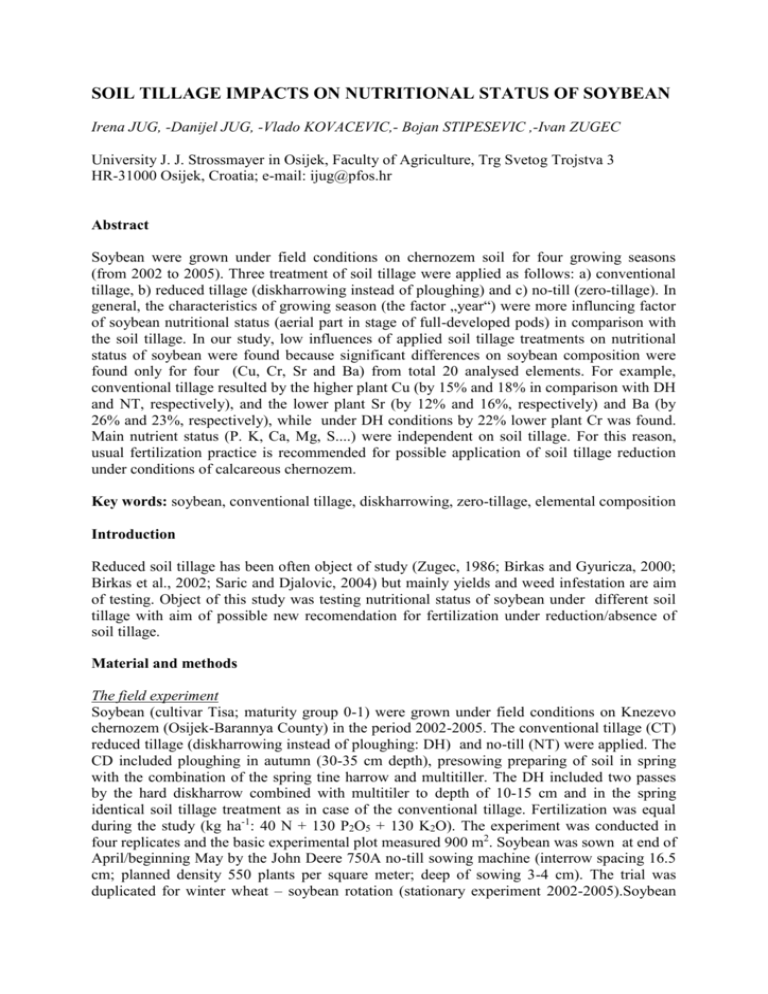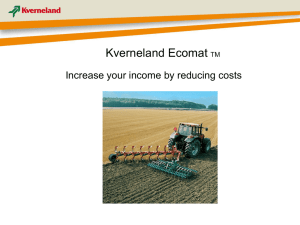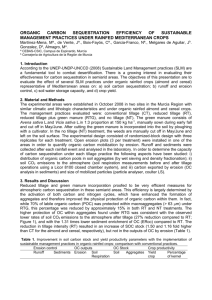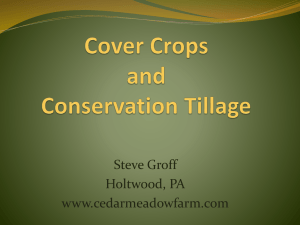SOIL TILLAGE IMPACTS ON NUTRITIONAL STATUS OF SOYBEAN
advertisement

SOIL TILLAGE IMPACTS ON NUTRITIONAL STATUS OF SOYBEAN Irena JUG, -Danijel JUG, -Vlado KOVACEVIC,- Bojan STIPESEVIC ,-Ivan ZUGEC University J. J. Strossmayer in Osijek, Faculty of Agriculture, Trg Svetog Trojstva 3 HR-31000 Osijek, Croatia; e-mail: ijug@pfos.hr Abstract Soybean were grown under field conditions on chernozem soil for four growing seasons (from 2002 to 2005). Three treatment of soil tillage were applied as follows: a) conventional tillage, b) reduced tillage (diskharrowing instead of ploughing) and c) no-till (zero-tillage). In general, the characteristics of growing season (the factor „year“) were more influncing factor of soybean nutritional status (aerial part in stage of full-developed pods) in comparison with the soil tillage. In our study, low influences of applied soil tillage treatments on nutritional status of soybean were found because significant differences on soybean composition were found only for four (Cu, Cr, Sr and Ba) from total 20 analysed elements. For example, conventional tillage resulted by the higher plant Cu (by 15% and 18% in comparison with DH and NT, respectively), and the lower plant Sr (by 12% and 16%, respectively) and Ba (by 26% and 23%, respectively), while under DH conditions by 22% lower plant Cr was found. Main nutrient status (P. K, Ca, Mg, S....) were independent on soil tillage. For this reason, usual fertilization practice is recommended for possible application of soil tillage reduction under conditions of calcareous chernozem. Key words: soybean, conventional tillage, diskharrowing, zero-tillage, elemental composition Introduction Reduced soil tillage has been often object of study (Zugec, 1986; Birkas and Gyuricza, 2000; Birkas et al., 2002; Saric and Djalovic, 2004) but mainly yields and weed infestation are aim of testing. Object of this study was testing nutritional status of soybean under different soil tillage with aim of possible new recomendation for fertilization under reduction/absence of soil tillage. Material and methods The field experiment Soybean (cultivar Tisa; maturity group 0-1) were grown under field conditions on Knezevo chernozem (Osijek-Barannya County) in the period 2002-2005. The conventional tillage (CT) reduced tillage (diskharrowing instead of ploughing: DH) and no-till (NT) were applied. The CD included ploughing in autumn (30-35 cm depth), presowing preparing of soil in spring with the combination of the spring tine harrow and multitiller. The DH included two passes by the hard diskharrow combined with multitiler to depth of 10-15 cm and in the spring identical soil tillage treatment as in case of the conventional tillage. Fertilization was equal during the study (kg ha-1: 40 N + 130 P2O5 + 130 K2O). The experiment was conducted in four replicates and the basic experimental plot measured 900 m2. Soybean was sown at end of April/beginning May by the John Deere 750A no-till sowing machine (interrow spacing 16.5 cm; planned density 550 plants per square meter; deep of sowing 3-4 cm). The trial was duplicated for winter wheat – soybean rotation (stationary experiment 2002-2005).Soybean seed was inoculated by Bradyrhizobium japonicum D344 (comercial name „Biofiksin-S“). Harvest of soybean was made by a small plot harvest combine. Sampling and chemical analysis Sampling of aerial part of soybean was made in the R-4 (full-developed pods) soybean stage. The samples (three replications of each treatment: total 36 samples) were prepared for chemical analyses by microwave digestion using 65% HNO3 + 30% H2O2. Analyses of 23 elements were performed with a Jobin-Yvon Ultrace 238 ICP-OES spectrometer in the laboratory of the RISSAC, Budapest, Hungary. The soil characteristics The experimental soil is classified as a calcareous chernozem on loess substrate. The soil is very favorable chemical properties (pH in H2O = 8.1, pH in 1n KCl = 7.5; humus = 2.6 %, CaCO3 = 2.1 %; AL-soluble P2O5 and K2O = 18.7 and 28.4 mg 100g, respectively). Butorac et al. (1986) ranged this soil type in the first category of suitability for reduced tillage. Weather characteristics Weather characteristics were mainly specific in comparison with long-term means. For example, precipitation in the period May-Sept. were by 15% higher, 47% lower, 2% higher and 70% higher for 2002, 2003, 2004 and 2005, respectively (Table 1). Table 1. Precipitation and mean air-temperatures (the data of Knezevo Weather Bureau) Knezevo (N:4582, E:1864): 2002-2005 and long-term means (LTM: 1965-2004) Precipitation (mm) Mean air-temperatures (oC) Month 2002 2003 2004 2005 LTM 2002 2003 2004 2005 LTM May 86 33 77 55 58 18.8 20.0 14.9 17.0 16.5 June 49 19 114 88 88 21.7 24.5 19.5 20.4 19.7 July 61 61 41 168 68 23.8 22.8 21.9 21.4 21.2 August 111 23 52 155 54 21.5 24.7 21.6 19.7 20.9 Sept. 63 34 43 82 55 15.9 16.4 15.9 17.5 16.4 Total 370 170 328 548 323 20.3 21.7 18.8 19.2 18.9 Results and discussion In general, the characteristics of growing season (the factor „year“) were more influencing factor of soybean nutritional status in comparison with the soil tillage treatments. Plant P and K were significantly higher in 2004 and 2005 (means by 31% and 51%, for P and K, respectively) compared to 2002 and 2003. At the other hand, plant Mg was in 2004 and 2005 by 22% lower in comparison with 2002 and 2003. Antagonism between K and Mg uptake were found also by the earlier studies (Kadar 2000; Kadar et al., 2000; Kovacevic et al., 2004). Specific nutritional status of soybean in one year in comparison with remaining three years were found as follows: the highest plant Cr and the lowest plant Co (by 74% and 66%, respectively), the highest plant Mn, Fe and Al (by 72%, 73% and 88% higher, respectively) in 2003, the highest plant S, Zn and B (by 31%, 50% and 38% higher, respectively) in 2004, the lowest plant Sr (higher by 31%) in 2004, as well as the highest plant Mo, Pb, Cd, Ba and Na (by 99%, 48%, 161%, 53% and 63% higher, respectively) in 2005. We found low influences of applied soil tillage treatments on nutritional status of soybean. Significant influences of soil tillage on soybean composition were found only for Cu, Cr, Sr and Ba. For example, conventional tillage resulted by the higher plant Cu (by 15% and 18% in comparison with DH and NT, respectively), and the lower plant Sr (by 12% and 16%, respectively) and Ba (by 26% and 23%, respectively), while under DH conditions by 22% lower plant Cr was found (Table 2). However, year x soil tillage interaction was significant for five elements (Mg, S, Fe, Co and Al) only under drougt stress of 2003 (Table 3). Table 2. Influences of the growing season and soil tillage on nutritional status of soybean The year (the factor A) and soil tillage (ST = the factor B: conventional = CT; diskharrowing = DH; no-till = NT) and composition of soybean (cultivar Tisa)** Year ST The aerial part of soybean at full-developed pods stage* (A) (B) Percent on dry matter basis mg kg-1 on dry matter basis P K Ca Mg S Zn Mn Fe Cu B 2002 0.316 1.85 1.67 0.636 0.171 21.9 38.6 158 9.4 37.6 2003 0.297 1.56 1.91 0.639 0.212 22.4 111.1 385 8.7 46.7 2004 0.407 2.49 1.75 0.470 0.265 34.3 69.2 229 10.3 59.2 2005 0.397 2.66 1.74 0.515 0.223 24.0 84.3 282 9.5 44.2 LSD A 5% 0.047 0.47 n.s. 0.101 0.034 3.7 26.5 127 n.s. 6.0 LSD A 1% 0.071 0.71 n.s. 0.051 5.6 40.2 n.s. 9.1 CT 0.370 2.18 1.68 0.538 0.226 25.3 71.7 272 10.5 46.8 DH 0.366 2.31 1.75 0.565 0.215 26.7 75.0 222 9.1 47.3 NT 0.327 1.93 1.87 0.592 0.212 25.0 80.7 296 8.9 46.7 LSD B 5% n.s. n.s. n.s. n.s. n.s. n.s. n.s. n.s. 1.3 n.s. Mean 0.354 2.14 1.77 0.565 0.218 25.7 75.8 264 9.5 46.9 mg kg-1 on dry matter basis mg kg-1 on dry matter basis Mo Co Ni Cr Sr Ba Al Pb Cd Na 2002 0.148 0.055 2.81 0.851 25.0 6.59 112 0.376 0.030 44.6 2003 0.198 0.160 1.83 0.609 21.1 6.64 312 0.336 0.042 29.3 2004 0.126 0.163 1.84 0.406 16.4 5.30 171 0.307 0.028 34.8 2005 0.313 0.174 2.44 0.450 21.3 9.48 215 0.503 0.086 59.2 LSD A 5% 0.090 0.040 n.s. 0.193 4.1 2.52 123 0.097 0.034 9.6 LSD A 1% n.s. 0.060 0.292 n.s. n.s. n.s. n.s. n.s. 14.5 CT 0.267 0.149 2.56 0.626 19.1 5.75 214 0.374 0.051 39.5 DH 0.175 0.120 2.14 0.485 21.7 7.80 163 0.394 0.043 41.6 NT 0.146 0.145 1.99 0.626 22.1 7.46 230 0.374 0.045 44.9 LSD B 5% n.s n.s. n.s. 0.126 2.5 1.70 n.s. n.s. n.s. n.s. Mean 0.196 0.138 2.23 0.579 21.3 9.48 215 0.381 0.047 42.0 * under detectable levels (mg kg-1): Se (<0.60), Hg (<0.12), As (<0.40) Bergmann (1992) described adequate levels of some nutrients in soybean (the uppermost fulldeveloped trifoliate leaf before anthesis) as follows (on dry matter basis)- %: 0.35-0.60 (P), 2.50-3.70 (K), 0.60-1.50 (Ca), 0.30-0.70 (Mg); mg kg-1: 30-100 (Mn), 25-60 (Zn), 10-20 (Cu) 25-60 (B), and 0.5-1.0 (Mo). In our study, according this criterion, adequate levels of Mg, B and Mn, moderate levels of P, K, Cu and Zn, as well as increased levels of Ca and Mo were found (Table 2). This nutritional status is mainly in accordance with chemical characteristics of the soil (alkaline reaction and calcareous substrate). The harmful elements monitoring, particularly Cd, Hg and Pb, have become important for environmental protection. Concentrations of these elements in the higher plants normally vary between 0.2 and 3.00 ppm Cd, 0.01 and 0.02 ppm Hg, 2 and 7 ppm Pb. High Sr contents in plants and diet are also toxic. We found very low levels of these elements in plants (Table 2) and it is in accordance by our earlier studies (Kovacevic et al. 2002; Bukvic et al. 2003). Based on our study, reduction or absence of soil tillage under conditions of calcareous chernozem of Barannya province had not serious consequences on nutritional status of soybean. For this reason, usual fertilization practice could be recommend for possible using of unconventional soil tillage practice. Table 3. Impact of interaction AB (year and soil tillage) on nutritional status of soybean The year (the factor A) and soil tillage (ST = the factor B: conventional = CT; diskharrowing = DH; no-till = NT) and composition of soybean (cultivar Tisa) Year ST The aerial part of soybean at full-developed pods stage (A)* (B) Percent on dry matter basis mg kg-1 on dry matter basis P K Ca Mg S Zn Mn Fe Cu B 2003 CT 0.320 1.65 1.67 0.560 0.230 21.1 90.1 296 10.3 46.3 DH 0.287 1.79 1.80 0.581 0.176 21.6 105.5 261 6.8 48.8 NT 0.283 1.25 2.26 0.776 0.229 24.6 137.7 597 8.9 45.0 LSD AB 5% n.s. n.s. n.s. 0.014 0.045 n.s. n.s. 186 n.s. n.s. LSD AB 1% n.s. n.s. 267 mg kg-1 on dry matter basis mg kg-1 on dry matter basis Mo Co Ni Cr Sr Ba Al Pb Cd Na 2003 CT 0.345 0.110 2.25 0.521 18.3 4.69 208 0.332 0.034 34.8 DH 0.122 0.112 1.71 0.457 20.8 7.21 229 0.306 0.041 23.0 NT 0.126 0.258 1.55 0.848 24.3 8.03 499 0.371 0.050 30.1 LSD AB 5% n.s. 0.089 n.s. n.s. n.s. n.s. 188 n.s. n.s. n.s. * non-significant (n.s.) differences among treatments for 2002, 2004 and 2005 By applied treatments, soybean yields were as follows (4-yr means: t ha-1): 4.25, 4.07 and 3.20, for CT, DH and NT, respectively (Jug, 2006). References Bergmann W. (1992): Nutritional disorders of plants - development, visual and analytical diagnosis. Gustav Fischer Vela Jena, Stuttgart, New York. Birkás M., Gyuricza Cs. (2000): Direktsaat-Dauerversuchsergebnisse mit Körnermais im pannonischen Produktionsgebeit Ungarns. Die Bodenkultur, 51 (1): 19-34. Birkás M., Szalai T., Gyuricza C., Gecse M., Bordás K. (2002): Effects of the disk tillage on soil condition, crop yield and weed infestation. Rostlinná Vyroba, 48 (1): 20-26. Bukvic G., Jolankai M., Josipovic M., Kovacevic V. (2003): Harmful elements contents (Sr, Hg, Pb and Cd) in soil and corn samples in the Eastern Croatia. In: 50 eves a magyar hibrid kukorica (Bedo Z. Ed.), Maguar Tudomanyos Akademia Mezogazdasagi Kutatointezete, Martonvasar. Hungary, p. 93-98. Jug D. (2006): Efects of reduced soil tillage on chernozem for winter wheat and soybean. PhD Thesis – in procedure. Faculty of Agriculture, University of Osijek, Croatia. Kadar I. (2000): Effect of mineral fertilization on the element uptake of maize (Zea mays L.) on chernozem soil. II. (in Hungarian with Eng. sum.). Novenytermeles 49 (1-2):127-140. Kadar I., Gulyas F., Gaspar L., Zilahy P. (2000): Mineral nutrition of maize (Zea mays L.) on chernozem soil. I. (in Hungarian with English Summary). Novenytermeles 49 (4): 371-388. Kovacevic V., Brkic I., Banaj D., Antunovic M., Simic D., Petosic D. (2004): Magnesium status in corn (Zea mays L.) hybrids and its relations to potassium and calcium. Cereal Research Communications 32 (4): 517-524. Kovacevic V., Kadar I., Koncz J., Brkic I., Banaj D. (2002): Cadmium and lead status in corn hybrids grown on acid soil of Eastern Croatia. Poljoprivreda 8 (1), 10-14. Saric T., Djalovic I. (2004): The effect of soil tillage systems, crop rotation and herbicides on johnsongrass control in maize. Herbologia 3 (2): 87–96. Zugec I. (1986): The effect of reduced soil tillage on maize (Zea mays L.) Grain yield in eastern Croatia. Soil & Tillage Research, 7. p.p. 19–28.







